Preface
The World Water Day Photo Contest wishes to contribute to the formation of a water culture for which everyone’s action is based on technical and scientific foundations.
The “White paper on water resources – Purification treatment, waste water, and reuse,” edited by Massimo Muscari of the Seregno AID Lions Club, communicates information and best practices, useful to large entities and individuals for a conscious and sustainable approach to the water resource.
We reproduce here some excerpts from the discussion.
1.1 – Water, a precious commodity
Water is a fundamental resource for humans as it is essential to life.
The human body is made up of 50-65% water, therefore it is a fundamental commodity for survival, although this is not the only reason why it is important for human life. Water is necessary for the most basic hygiene practices, is a precious commodity for agricultural, industrial, and energy production and, last but not least, is important for the stability of the entire ecosystem.
As a renewable resource, it is supplied in large quantities by the very nature of our planet but unevenly distributed and not proportionate to the people who need it and use it. In recent years the availability of fresh water per capita (indispensable for human health) is significantly decreasing due to various factors such as population increase and the improper treatment of water by people themselves who contaminate and waste it.
This compromises the natural water cycle that allows its renewal through precipitation, which returns water that has evaporated from the surface of the Earth to the ground. Nevertheless, it does not decrease the total amount of water available; instead an increasingly consistent part is altered and made unusable because it is polluted by humans during the natural cycle.
For this reason, special attention should be given to this resource to protect its quality and increase distribution.
It is therefore desirable to be able to prevent water pollution and the depletion of the resource by planning in advance the correct management of the available water in each country, through the consideration of the uses of the water in relation to its various characteristics and the construction of plants to be able to treat water for purification, disposable, or possible reuse.
So by designing a connected process of the various water treatments, we can ensure water savings, especially in countries where it is scarce, and better quality, by limiting consumption as much as possible and investing in water reuse.
In this regard, the methods to achieve these goals are:
- prevent and reduce pollution and implement the recovery of polluted water bodies;
- achieve the improvement of water condition and adequate protection for water intended for particular uses;
- pursue the sustainable and enduring use of water resources, with priority given to potable water;
- maintain the natural ability of water bodies to self-purity, as well as the ability to support large and diversified animal and plant communities.
1.2 – Water: characteristics and resource management
As much as 70% of the Earth is covered with water but all of it is not immediately available and does not have the same characteristics. Of this, 97% is made up of salt water (seas and oceans) while only the remaining 3% is fresh water, which is present in nature with a low concentration of salt and is considered suitable for extraction and treatment in order to produce potable water.
For a more in-depth look at the sources of fresh water and related treatments, refer to the subsequent chapters regarding purification. Here we state in advance, however, that it is fundamentally important to safeguard our reserves of fresh water as necessary to human health and subject to depletion. In fact, once used, its properties are altered and it must be treated again with specific procedures but it can no longer be made potable.
Within a territory, water resources appear under various aspects. Below is a preliminary classification of the sources that are generally available:
- Surface waters: this includes inland waters (except ground water), transitional waters and coastal waters. Inland waters refers to all of those within the territorial boundaries.
- Rivers: flowing bodies of water on the surface (but there may be underground sections). They reach edge of the transition waters, which vary for each watercourse.
- Lakes: bodies of water that are lentic, or still, and not temporary. Both natural and man-made bodies of water are considered lakes if they have a surface greater than 0.5 km². The definition of lakes also includes those with an effluent flow.
- Coastal waters: surface waters located inland when compared to an imaginary line that is equidistant one nautical mile from the baseline that serves as a reference to define the limit of territorial waters; salty composition.
- Transition waters: bodies of water on the surface near river mouths which are partly saline because of their proximity to coastal waters but are substantially influenced by freshwater flows.
- Groundwater: all waters found below the surface of the ground in the saturation area and in direct contact with the ground or subsurface.
Therefore, in order to create a good “management plan” for hydrogeographic basins and take into account all water sources the region offers, the following is necessary:
- assess the various bodies of water available, that is the surface or underground sources, and carry out a precise cartographic reporting by type of resource and perimeter extension, specifically indicating areas that are particularly at risk or protected areas;
- evaluate the existing quality and quantity of water bodies, through special analysis;
- make reference estimates that especially consider the level of human activity on the resource and the level of pollution present. It is also essential to prepare a cartographic support to report human activity in the area, identifying all the places of water extraction and draining;
- provide a monitoring network, with additional related cartography for areas that are monitored;
- plan a water management system aimed at water savings that includes the search for a balance between the extractions performed and the waters restored (consumption refers to the water that is completely absorbed and not returned to the environment). It should also allow the use of natural sources of fresh water for human consumption only when there are no viable alternatives available;
- aim at maintaining (or improving) the quality of the resource and its availability over time, still promoting the protection of potable water over others.
The evaluation of the quality of bodies of water present in the territory is useful for proper, preliminary water management planning because the entire management program must be calculated on the current conditions and must pursue (also for the future) specific “quality objectives”:
- “environmental for significant bodies of water”: that is, ensure for each body of water the ability to self-purify naturally and protect the quantity and quality of the resource over time, quantifying the impact of human use of the resource.
- “by specific destination”: that aims to identify water bodies with characteristics suitable for human consumption and the maintenance of fish and shellfish.
Therefore, the primary purpose of this analysis is to determine the condition of water reserves and take action to improve or maintain good conditions, if they do not reach a standard specified by the technical parameters.
1.3 – Water uses
Having established, therefore, that water in nature does not always present the same chemical and physical qualities, specific uses have been defined for each type of water by virtue of its different properties.
For the classification of water uses, refer to the European guidelines created with the intent to find a good compromise between the needs of the Member States of the European Community.
Once the water quality (which has definite corresponding chemical, physical, and microbiological characteristics) of a water body has been verified, it can be directed to different uses on a general level which can be distinguished as follows:
1) CIVIL USES: water for this use must be potable, if aimed primarily at satisfying human thirst. All functions related to personal hygiene and other domestic practices related to food also fall under this category. For other kinds of uses (street washing, resources for fire-fighting systems, heating for buildings, watering green areas not open to the public) is not necessary to use potable water. Major sources of supply are natural fresh water, such as groundwater and surface water.
It is calculated that on a global level, the percentage of water intended for these purposes is an average of around 10%.
2) IRRIGATION USES: the percentage of water required by the agricultural sector is estimated at 70% worldwide, assuming however that it reaches 90% in countries affected by an arid climate where agriculture is hampered by the high temperatures and the high rate of evaporation.
Useful for irrigating agricultural land or in greenhouses and livestock, it is extracted from underground and surface sources and artificial bodies of water (that is, man-made), sources upon which the water quality itself depends.
Benchmarks used to authorize the use of water for irrigation are based on FAO indications, variously implemented by the Member States of the European Community. In recent years there has been increased attention to the monitoring of chemical elements that are harmful to humans
– in water used to produce food, especially those eaten raw, nitrates are particularly kept under control.
3) INDUSTRIAL USES: water reserved for the industrial sector (about 20%, again on a worldwide average) is generally extracted from wells or structures dug into the ground to allow extraction from the subsoil. It is used for machining processes in the industrial sector and for cooling equipment or heating buildings. Potable water is not required for these uses (and it would be better if the states used valid alternatives to it)
so it is very convenient to use purification mechanisms to be able to reuse the same water. The only situations in which the use of potable water is required are in the production and conservation of foods meant for human consumption.
4) ENERGY USE: water can be used to produce renewable energy through various procedures. In hydroelectric power plants, mechanical energy is derived from the movement triggered by large bodies of water, which are conveyed in the plant and poured over special machinery. This mechanical energy then becomes convertible into electricity. In thermoelectric power plants the process starts with the combustion of fossil fuels that heats the water and turns it into steam. In this state the water moves electric generators to create mechanical energy that can also be turned into electricity.
Significant amounts of water are needed for this and therefore it is prudent to not use natural fresh water for this type of use but rather to employ already used water or sea water, when possible.
Obviously, prudent planning of water use must take into account the need for adequate plants for the collection and disposal of wastewater, considering the impact that these can have on the territory.
Also, the possibility of employing wastewater for the uses listed above once it has been adequately treated is particularly advantageous because then it is possible to limit the consumption of natural sources and offer a valid alternative.
The use of only potable water is forbidden for this use.
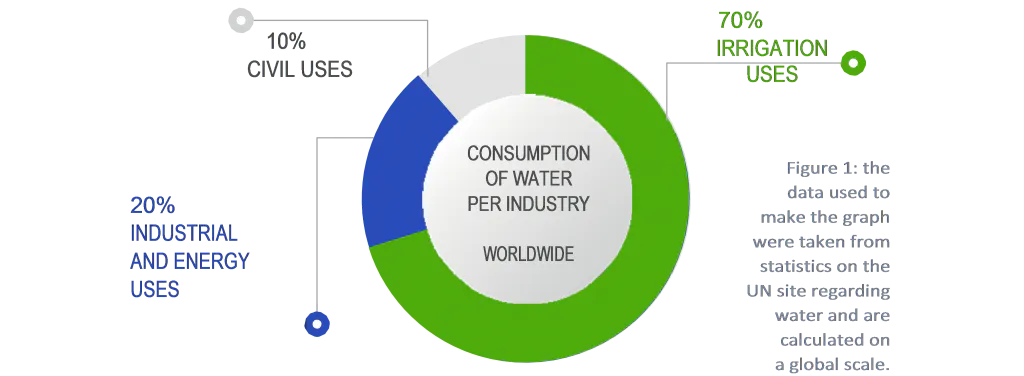
2.1 – Potable water supply sources
Of the 3% of fresh water available on the earth’s surface, most of it (almost 70%) is in the solid state (polar ice caps and mountain glaciers), 30% of it runs underground (groundwater) and only 0.3% is found in surface waters (lakes, rivers).
Therefore, fresh water not only makes up a small quantity of the total, it is not immediately usable by man in its entirety and often is lacking in dry tropical countries where there is a higher percentage of evaporation and precipitation is very rare. This combination of factors, put these regions continuously at risk of a water deficit.
We have already discussed the importance of fresh water for human health (as the primary natural source of potable water based on its low salinity) and the potential risk of depletion if not protected from pollution and waste.
The primary natural sources of fresh water where extraction is generically authorized for the supply of potable water are both surface and underground waters but, on a practical level, the following requirements apply:
- the preferred source is aquifers since underground water is usually purer because it has less human impact. Extraction is usually through man-made wells for pumping water from the subsurface;
- from surface waters after suitable treatments based on the source location;
- from bodies of water that have been previously evaluated to have a sufficient flow to satisfy the needs of an adequate number of people and not subject to the risk of depletion.
It is possible, however, to also extract potable water from sources that are not suitable by nature, like salt water from both the sea and surface or subterranean brackish waters.
In each of these cases, however, the water cannot be simply intended for human consumption but must be subjected to specific analysis and treatments.
2.2 – Quality parameters for water intended for human consumption
Potable water (intended to satisfy thirst) falls under the classification of “water intended for human consumption”, a category that also includes those used for food production and those useful for other types of domestic use. These types of water, all absolutely judged as being suitable for consumption, are supplied to houses through the distribution network (aqueducts) or in bottles or containers. Potable waters must first be “wholesome” and “clean” in order to ensure the greatest possible safety to human health. It must also meet special characteristics as follows:- on the physical level it must be odourless, tasteless, and colourless with an extremely low level of turbidity;
- on the microbiological level it must not contain micro-organisms that are pathogenic and harmful to humans;
- on the chemical level, it must have components kept within the recommended standards.
- For fresh water from the surface:
- Category A1: simple physical treatment and disinfection;
- Category A2: normal physical and chemical treatment and disinfection;
- Category A3: extreme physical and chemical treatment, refining and disinfection.
- For underground waters a similar classification is not necessary since they are better protected from pollutants being filtered by the ground. It is, however, recommended to perform analyses to prevent any damage to human health created by pollution due to the discharge of harmful substances, especially if found in industrialized areas.
3.0 – Wastewater
Social, productive and recreational activities, mainly in urban areas, require and use a large amount of water.
The direct consequence of water use is the alteration of its properties and the inevitable production of discharges which, in order to be returned to the environment, must necessarily undergo purification treatment. The sea, rivers and lakes are unable to receive a quantity of pollutants in excess of their self-purifying capacity without seeing the quality of their water and the normal balance of the ecosystem compromised.
Thus, there is a clear need to purify wastewater through treatment systems that mimic the biological processes that occur naturally in water bodies (however, purification is much faster in plants than in waterways, thanks to the technology and energy used). Wastewater treatment is all the more stringent the more the receiving water bodies (seas, rivers, lakes, etc.) are at risk of permanent pollution.
3.1 – Classification and derivation of wastewater
Wastewater is mainly classified according to its origin, which is the place and method in which they were used before their discharge. The primary origins are civil and industrial use.
Waters for civil use include:
- domestic wastewater: wastewater from residential communities and services and primarily from human metabolism and domestic activities;
- wastewater treated as domestic: wastewater with qualitative characteristics that are equal to domestic ones. These values are expressed in Table 1 in the Appendix.
Water for industrial use refers to wastewater from buildings or installations where a trade or production of goods is carried out and is qualitatively different from domestic wastewater and runoff.
The appendix also contains the definition of runoff water and urban wastewater that complete the picture on the classification of wastewater
3.2 – Possible discharge points
For the classification of wastewater reception bodies, we distinguish three primary discharge points:
- surface waters, or those present on the earth’s surface such as road ditches, hollows and canals, streams, artificial water bodies, rivers, lakes, and the sea;
- the ground or the surface layers of the subsoil: that is, the surface of the earth that is uncultivated, agricultural or urban
- sewer system: the sewage networks serving the conglomerations.
Special attention must be paid to discharges near areas that are defined as sensitive, where the quality of water from natural sources may be compromised.
A water system that can be classified in one of the following groups is considered a sensitive area:
a) natural lakes and other fresh waters, estuaries, and waters which are eutrophic;
b) fresh surface waters intended for the production of potable water;
c) areas that, due to discharges, require additional treatment to the secondary treatment.
To identify which nutrient should be reduced through further treatment, the following elements should be considered:
a) in lakes and water courses that flow into lakes/basins/closed bays with limited water exchange and were accumulation of nutrient substances such as nitrogen and phosphorous can occur which gives rise to the production of algae and aquatic plants with a subsequent decrease in oxygen dissolved in the basin and introduces an anaerobic regime that leads to the destruction of every vital organism;
b) in estuaries, bays, and other coastal waters with poor water exchange or in which large quantities of nutrients flow if, on one hand, discharges from small urban conglomerates are generally of irrelevant importance, on the other hand those from larger conglomerates make elimination interventions necessary.
3.3 – Emission limits
Discharges into surface water bodies
All discharges into surface water bodies must be resolved on the basis of respect for the quality objectives of the receivers.
If water is taken from surface water bodies, it must be returned with quality characteristics that are not worse than those taken.
Discharges on the soil and in the subsoil
The values in Table 3 in the appendix indicate the limit parameters that it would be proper to follow in the event of discharges on the ground, only authorized in situations where it is impractical to discharge into a body of water.
Discharge of dangerous and pollutant substances into the soil and subsoil is prohibited (organophosphorus compounds, mercury and mercury compounds, cyanides, etc.).
Discharges in the sewer system
The discharge into the sewer system is performed according to the type of treatment that is performed downstream of it.
The discharges must be made accessible for sampling to allow checks in the measurement point. The measurement of the discharge is intended to be carried out immediately upstream of the point of entry for all surface waters and groundwater, inland waters and marine waters, as well as in sewers, soil and subsoil.
3.4 – Treatment techniques
For purification of municipal wastewater, treatment plants are chosen to be arranged in order to minimize effects on the receiving body.
The appropriate treatments should be identified with the objective being to:
- simplify maintenance and management;
- be able to adequately support great hourly variations of the water and organic load;
- minimize management costs.
Three types of treatment can be distinguished: primary, secondary, and tertiary, according to the technical solution adopted and purification results to be reached
3.5 – The future
One objective: re-use Apart from the need for purification processes in terms of environmental impact, proper management of the water cycle involves the application of existing technological knowledge for the achievement of socially and economically useful objectives, such as the protection of surface water bodies and underground and proper management of water resources. Re-use of purified wastewater can be considered an innovative and alternative expedient within a more rational use of the water resource. The economic advantage gained by re-use is in providing the community with water procurement, at least for certain uses that do not require high quality water, at lower costs, because recycling costs less than disposal. The re-use of domestic, municipal, and industrial wastewater through proper regulation of the intended use and the related quality requirements to protect the quality and quantity of the water resources can lead to the decrease of the withdrawal of surface and underground waters, reducing the impact of the discharges in receiving water bodies and promoting water savings through the multiple use of wastewater. Advantages and future prospects that can offer recycling of used water include new technologies that seek to obtain efficient processes guaranteeing procurement of purified water at low cost, with a certain degree of quality, especially health and hygiene. Conventional treatments are almost never enough and therefore technology is aimed towards the fine tuning of new tertiary and disinfection treatment alternatives aimed at high water quality through the abatement of the microbial load, nutrients, and toxic substances (membrane plants, ozone, ultrafiltration, etc.).4.0 – Reuse of wastewater and rainwater
To ensure protection of the quality and quantity of water resources it is hoped to limit the collection of surface water and groundwater, reducing the impact of the discharges on the receiving water bodies and favouring water savings through the recovery and reuse of wastewater.
In a generic user, in order to satisfy water needs, potable water having high quality characteristics is collected and used without distinction for potable or non potable purposes. This is called double waste, because it uses high quality water for non potable purposes, discharging it immediately after. As already stated, potability conditions cannot be restored after use.
Just by considering the use of potable water in houses it is evident that its use is not always appropriate. Only a small percentage is used for drinking and preparing food while the remaining part is consumed for other uses.
Sustainable management of the water cycle is based instead on leveraging less noble water and using high quality water only where potability characteristics are truly required..

A correct practice calls for the insertion of these principles in the regulations governing the matter.
Re-use must occur in environmentally safe conditions, avoiding changes to the eco-systems, soil and crops, as well as health and hygiene risks for the exposed population.
The term recover refers to the requalification of wastewater through adequate purification treatment in order to make it suitable for distribution for specific reuses.
Re-use calls for the use of recovered wastewater of a certain quality for a specific use through a distribution network, in partial or total replacement of surface or underground water.
4.1 – Possible ways to reuse wastewater and rainwater
The allowable uses of recovered wastewater are as follows:
- irrigation: irrigation of crops for the production of food for human and animal consumption, for non-food uses as well as for irrigation of green areas or for leisure or sporting activities;
- civil: for the washing of the streets in urban centres; for the power supply for heating or cooling systems; for feeding dual adduction networks separate from those for potable water, with the exclusion of the direct use of such water in buildings for civil use, with the exception of discharge systems in sanitary facilities;
- industrial: as water for fire extinguishing, process, washing and thermal cycles of industrial processes, with the exclusion of uses that require contact between the recovered wastewater and foods or pharmaceutical and cosmetic products.
Purified wastewater is forbidden for use as potable water or when in direct contact with raw edible products.
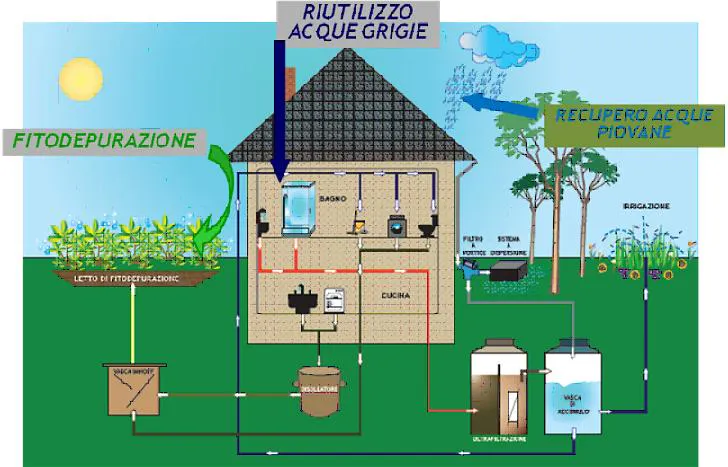
4.2 – Type of recovery
RAINWATER RECOVERY
Plants intended for wastewater recovery allow the re-use of rainwater, storing it in a reserve tank.
These plants allow the creation of the possibility to recover rainwater that, rather than being dispersed, can be used for external and internal uses.
External uses
- watering of public or condominium green areas;
- washing paved areas;
- car washes, meaning businesses;
- technological uses and supplying fire extinguishing systems.
Internal uses
- filling toilet flush tanks;
- filling washers (if prepared);
- water distribution for basements and car washing;
- various technological uses such as, for example, passive/active air conditioning systems.
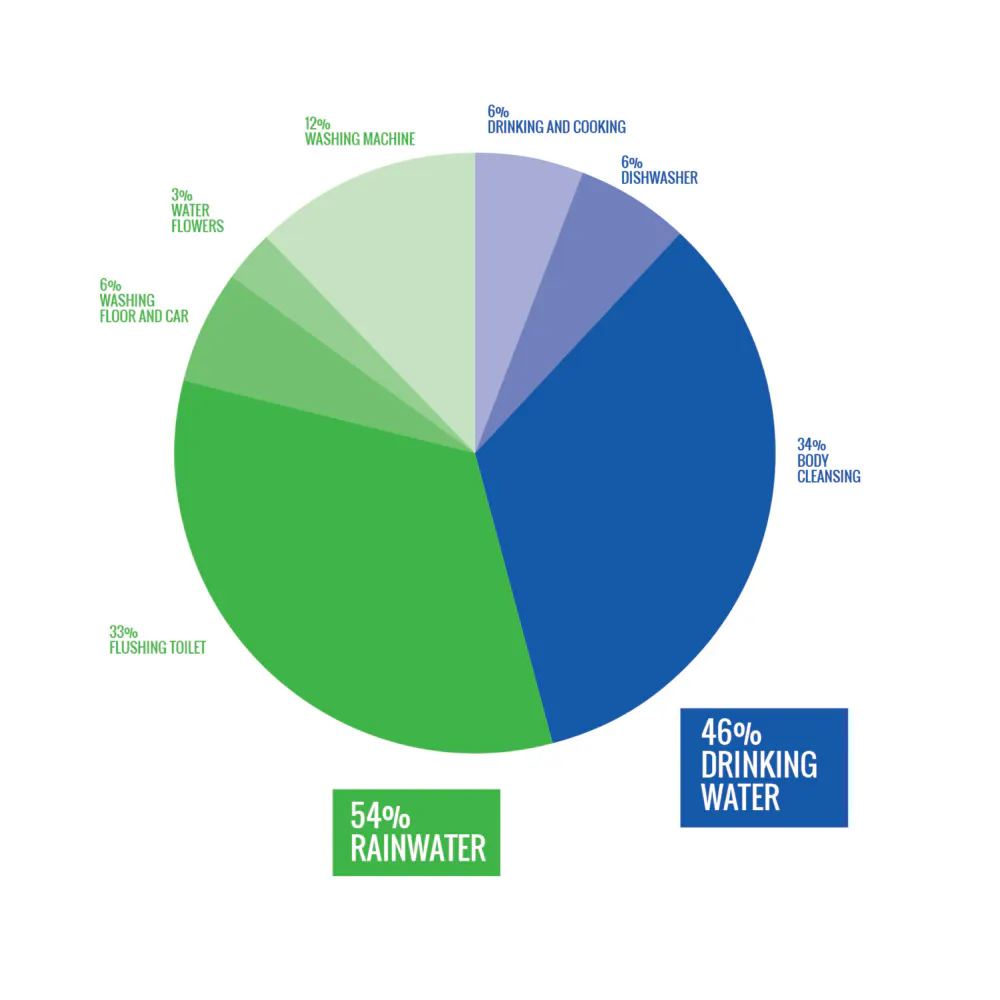
RECOVERY PLANTS
The plant for optimizing rainwater recovery is made up of a filtering and storage part and an actual re-use part.
The plant usually has four intervention phases:
1) Water is collected from the gutters and conveyed to a filter that separates the water from larger suspended material.
2) Water is channelled inside the tank through a pipe so no turbulence is created.
3) Subsequent intake of the water in the tank occurs a few centimetres below the water level in order to collect cleaner water.
4) An electronic control unit controls a feed pump and the entire system.
The characteristic components of a rainwater recovery plant are:
• Diverter/Filter
The diverter separates the first flush (generally having more pollutants) from the water intended for storage.
The filter keeps any foreign bodies in the rainwater from entering the tank.
• Tank
The tank is the heart of the entire rainwater recovery system.
The ideal conditions for water conservation are: oxygenated environment and the absence of light.
The choice of the type to be adopted depends on various factors.
a) Position. The position influences the distribution system (with or without pump) and its uses, the installation and maintenance costs, the form (compact for inside, resistant for being buried) and the materials used. The tank can be placed above ground (it generally contains water intended for irrigating or washing and the like), inside the building (in premises at ground level or underground) and buried (the most expensive due to the excavation necessary, but it has the advantage of keeping the shape of the tank out of view and allows the installation of large capacity items).
b) Capacity: to size these plants and to then determine the volume to assign to the accumulation tank, both the environmental characteristics (local rainfall, size and type of the collection surfaces, etc.) and the performance required (in relation to the number of inhabitants) must be evaluated.
c) Material: The tanks are made of materials that are compatible with the standards. They are generally made of fibreglass, polyethylene, or are made of concrete poured on site.
• Drain pipe
The drain pipe, shaped like a siphon, prevents the backflow of unpleasant odours from the disposal system. It is at a height equal to or lower than the input.
• Check valve
The check valve prevents the contamination of the water stored in the tank, inhibiting backflow of waters from the disposal system.
It is normally equipped with a grating filter that blocks access to the tank and other components upstream and animals and insects that could enter from the drain.
• Delivery pump
The delivery pump, controlled by an electronic control panel, picks up the water stored in the tanks and distributes it to the equipment that reuses it.
To prevent contamination, pipes and terminals on the recycling plant must be clearly marked and separate from those for potable water.
Refinement treatments for recovered water
After primary filtration of the large material, recovered rainwater can only be reused for irrigation with a subirrigation system.
For all of the other non-potable uses, a refinement phase is usually required to improve the quality characteristics of the water, especially regarding SS, BOD5, and bacteria.
Four systems are recommended as refinement treatments:
• disinfection (hypochlorite, UV, dioxide, etc.);
• filtration (sand and carbon);
• membrane filtration;
• phytotreatment.
For the description of the techniques listed, refer to the previous chapters regarding potable water and wastewater.
The advantages from the installation of rainwater collection plants for individual use can reflect positively on both the private level:
• water savings;
• economic savings considering that the re-used water is free;
• absence of limescale deposits in pipes and on heating elements in machines (washer, dishwasher) and subsequent savings on electrical consumption;
• detergent savings (up to 50%) due to lower water hardness.
and the public level:
• they prevent the recurrence of overloading of sewer and disposal systems during heavy precipitation;
• they increase the efficiency of the purifiers (where the white and black sewer systems are not separate) subtracting large amounts of liquid from the outflow that, diluting the amount of slurry to be treated, will reduce the effectiveness of the biological purification phase;
• they retain and/or disperse the excess rainwater on site (for example during heavy storms) that is not absorbed by the ground on the municipal level due to the progressive impermeabilization of the soil, making upgrades to the public collection systems useless.
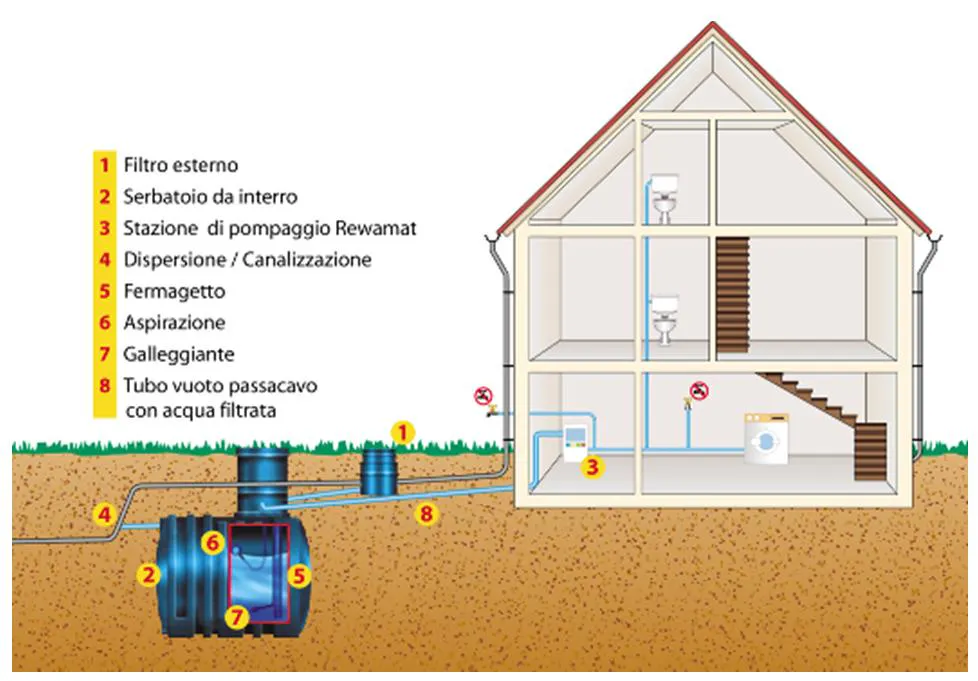
GREY WATER RECOVERY
Grey water refers to water from sinks, showers, and bath tubs (except for the toilet, bidet, and the entire kitchen) and that, due to their degree of contamination, can be collected, treated, and disinfected to then be returned for domestic use (inside rinse tanks) or reused for irrigation.
Operations regarding “grey water” are fundamentally comprised of:
• separation of the discharge networks of black water (containing toilet discharge) and grey water (all other discharged water);
• creation of distinct water distribution networks (potable water and non-potable water);
• treatment and re-use of purified grey water for non-potable uses such as irrigation of green areas, filling toilet flush tanks, and washing external areas.
Grey water recovery and re-use systems can reduce the consumption of potable water with particular efficiency in medium-large buildings or complexes that produce a consistent quantity of wastewater each day.
These buildings can be: hotels, guest houses, tourist facilities, retirement homes, housing complexes, apartment buildings, campsites, fitness centres, sports halls, swimming pools, hair salons, office buildings, motorway services, and companies which use showers.
Storage of grey waters is through underground tanks or tanks installed inside the building.
Grey water can be treated with a biological oxidation system or with an ultrafiltration system.
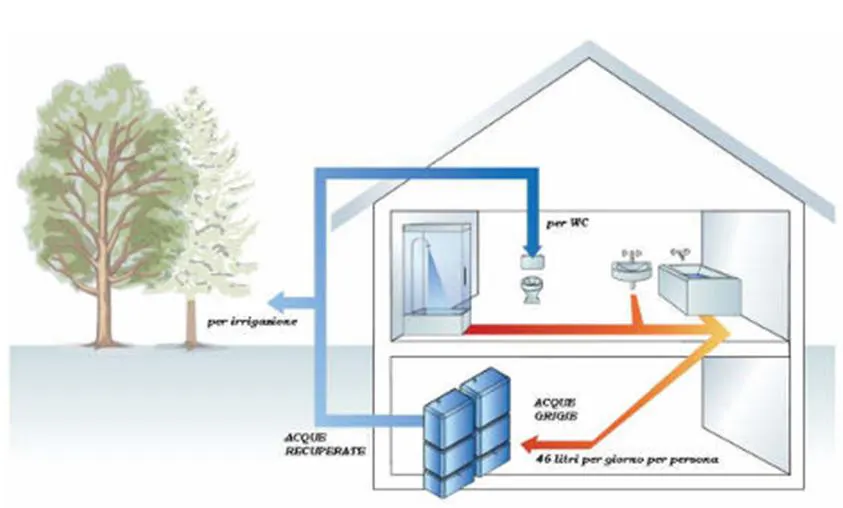
WASTEWATER RECOVERY
Water demand has grown in recent decades and is likely to expand further, due to social and cultural factors and the development of urban conglomerations and production companies. UN estimates predict a strong growth in the world population that, in 2025, will be about 9 billion people, 50% of which will be concentrated in the larger towns.
It is therefore necessary to intervene in order to ensure a water supply for the future, limiting the exploitation of water resources and protecting the receiving bodies.
The re-use of domestic, urban, and industrial wastewater purified with tertiary type innovative systems (membrane plants, ozone, ultra filtration, etc.) is one of the most effective methods for meeting the objectives listed above.
Purified water must meet a certain degree of quality, especially at the health and hygiene level. There is a long list of illnesses (dysentery, gastroenteritis, allergies, etc.) that can be contracted through wastewater and it is more than evident that there is a need for water disinfection for its re-use.
On the disinfection level, three primary objectives must be established: reduction of the microbial load, control of the chemical elements present, and limitation of possible contact between people and the wastewater.
It is important to diversify the complexity of the treatments and the re-use environments depending on the origin of the wastewater. Treatment plants can be set up to treat water from city drains (municipal wastewater) or industrial drains (industrial wastewater).
Based on the type of re-use, a more or less intense treatment will be performed. The complexity of the process used to treat the wastewater call for increasingly elevated quality levels depending upon whether it will be for agricultural, industrial, or potable re-use.
Possible uses
- Reuse for agriculture is one of the most adopted solutions, in various areas. These are mainly:
- direct use (in which the wastewater, which is more or less refined, is directly re-used for irrigation);
- indirect use (where the wastewater is put into a water body destined for irrigation use).
- Even industrial re-use has two possible solutions:
- reuse for general services (essential heating and cooling circuits);
- specific re-uses in various technological cycles (textiles, tanning, paper mills, steel mills, etc.).
- Re-use for potable use which calls for compliance with high quality standards (to prevent contamination with harmful and damaging substances), is divided into two types:
- a “direct” (closed cycle) re-use that calls for direct inflow of the treated wastewater in the water distribution system;
- “indirect” re-use that calls for intermediate storage of the wastewater in an artificial or natural basin before distribution in the network.
- Another category for re-use is for civil, non potable uses such as: irrigation of parks, green areas, and sports fields; domestic use in hygiene services (not in contact with people); commercial uses (e.g.: car washes); ornamental uses (e.g., fountains) that can be supplied by the so-called “dual systems” of distribution (with a network that transports “potable” water and another that contains re-use water for “non potable” use).
Bibliography
- E. Aimo, General aspects of drinking water quality, in “Radioactivity in drinking water and the twinning of ARPA Veneto and ARPA Lombardia with Poland,” seminar December 4, 2007, Verona
- L. Lamberto, Techniques for the reuse of purified water for emergency water supply.
- L. Meucci, The potabilization treatments
- F. P. Nicese, Possibility of wastewater commitment for irrigation of green areas
- M. Sala, The discharge of wastewater – Regulatory references, in “Phytodepuration Seminar – Regulatory framework and new design tools,” May 31, 2013, Reggio Emilia
- Guidelines on treatment devices for water intended for human consumption under Ministerial Decree February 7, 2012, no. 25
- Regulations for the adjustment of effluent discharges from isolated settlements that cannot be connected to dynamic sewer networks of the Municipality of Cavallino-Treporti, April 27, 2011
- Italian water legislation
- www.arpa.emr.itThe drinking water systems
- www.idra.unipa.itLecture on drinking water quality
- www.unwater.org/worldwaterday

